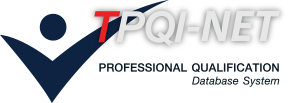หน่วยสมรรถนะ
Interpret work health and safety practices in aviation maintenance.
สาขาวิชาชีพการบิน
รายละเอียดหน่วยสมรรถนะ
| 1. รหัสหน่วยสมรรถนะ | AVT-FTN-3-012ZA |
| 2. ชื่อหน่วยสมรรถนะ | Interpret work health and safety practices in aviation maintenance. |
| 3. ทบทวนครั้งที่ | - / - |
| 4. สร้างใหม่ |
|
ปรับปรุง |
|
| 5. สำหรับชื่ออาชีพและรหัสอาชีพ (Occupational Classification) | |
|
101 Aircraft Mechanics: Airplane 102 Aircraft Mechanics: Helicopter 103 Aircraft Mechanics: Avionics |
|
| 6. คำอธิบายหน่วยสมรรถนะ (Description of Unit of Competency) | |
| This skill unit covers the skills and knowledge necessary to comply with work health and safety (WHS) regulation and work safely in aircraft maintenance areas. It requires the application of relevant WHS practices to aviation maintenance workplaces to ensure his own safety and that of others in the workplace. Workplaces include flight line or tarmac, hangars and workshops. Maintenance activities include all planned and unplanned maintenance on fixed planes or rotary wing and components thereof. The work can be done individually or as part of a team. | |
| 7. สำหรับระดับคุณวุฒิ |
| 1 | 2 | 3 | 4 | 5 | 6 | 7 | 8 |
|---|---|---|---|---|---|---|---|
| 8. กลุ่มอาชีพ (Sector) | |
| 7232 AircraftMechanics | |
| 9. ชื่ออาชีพและรหัสอาชีพอื่นที่หน่วยสมรรถนะนี้สามารถใช้ได้ (ถ้ามี) | |
| N/A | |
| 10. ข้อกำหนดหรือกฎระเบียบที่เกี่ยวข้อง (Licensing or Regulation Related) (ถ้ามี) | |
| ICAO Doc 7192 / EASA Part 66 | |
| 11. สมรรถนะย่อยและเกณฑ์การปฏิบัติงาน (Elements and Performance Criteria) |
| หน่วยสมรรถนะย่อย (EOC) | เกณฑ์ในการปฏิบัติงาน (Performance Criteria) | รหัส PC (ตามเล่มมาตรฐาน) |
รหัส PC (จากระบบ) |
|---|---|---|---|
| 101301.01 Interpret safe work practices, reporting procedures for workplace hazards. | 101301.01.01 Able to interpret and understandRelevant regulatory and enterprise policies and procedures that identify therequirements for conduct of safe work, to identify Workplace housekeepingmeasures in accordance with standard enterprise procedures, to identify andunderstand the use of personal protective equipment (PPE) and maintenance measures are interpreted and understoodaccording to regulatory and enterprise procedures. | 101301.01.01 | 70952 |
| 101301.01 Interpret safe work practices, reporting procedures for workplace hazards. | 101301.01.02 Able to identify andunderstand safety signs and symbols, and their directions observed inaccordance with enterprise and safety requirements, to identify workplacehazards correctly and able to interpret and understand reporting proceduresaccording to standard enterprise procedures. | 101301.01.02 | 70953 |
| 101301.02 Interpret emergency procedures. | 101301.02.01 Able to contact the appropriate personnel and emergencyservices in the event of an accident using appropriate method according toenterprise requirements. | 101301.02.01 | 70954 |
| 101301.02 Interpret emergency procedures. | 101301.02.02 Able to interpret andunderstand emergency and evacuation procedures to ensure safe conduct ofpersonnel according to enterprise procedures, correctly identify the use ofemergency equipment according to regulatory or enterprise procedures. | 101301.02.02 | 70955 |
| 12. ความรู้และทักษะก่อนหน้าที่จำเป็น (Pre-requisite Skill & Knowledge) | |
| N/A | |
| 13. ทักษะและความรู้ที่ต้องการ (Required Skills and Knowledge) | |
|
(ก) ความต้องการด้านทักษะ See Appendix A (ข) ความต้องการด้านความรู้ See Appendix A |
|
| 14. หลักฐานที่ต้องการ (Evidence Guide) | |
|
|
|
| 15. ขอบเขต (Range Statement) | |
|
|
|
| 16. หน่วยสมรรถนะร่วม (ถ้ามี) | |
| N/A | |
| 17. อุตสาหกรรมร่วม/กลุ่มอาชีพร่วม (ถ้ามี) | |
| N/A | |
| 18. รายละเอียดกระบวนการและวิธีการประเมิน (Assessment Description and Procedure) | |
|
• applying general duty of care under WHS legislation and common law • fluid and gas high and low pressure systems, including fluid handling (for example, hydraulic fluids, lubricants, compressed air, nitrogen and oxygen) • fuelling/defueling and working on fuel systems using and handling chemicals, including solvents and battery acids electrical systems, outlets and leads noise hazard areas and aircraft safety zones aircraft handling, towing, jacking, ground equipment operation and signage personal protection housekeeping and cleaning, waste disposal and FOD prevention practices and procedures. • Also, where applicable to the enterprise, the following: • confined space entry • aircraft strobe lighting • ionizing, non-ionizing radiation equipment
|
|
